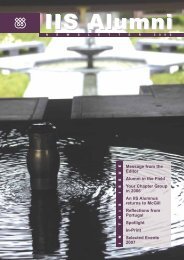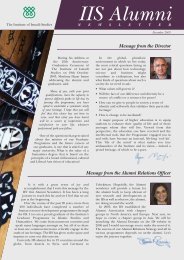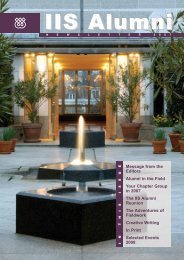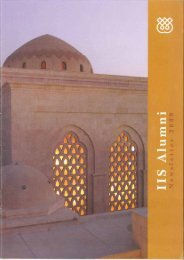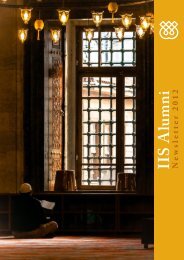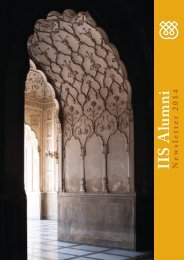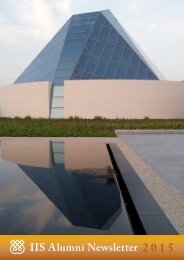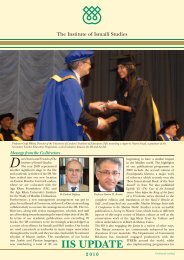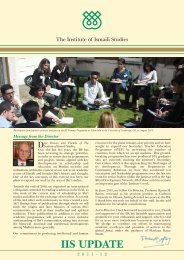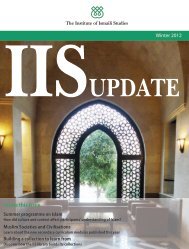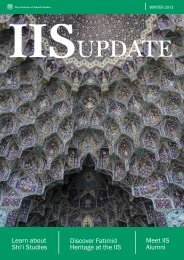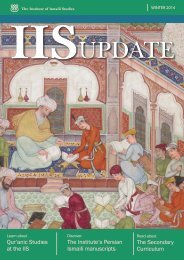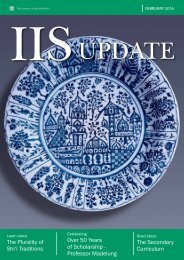IIS Alumni Newsletter 2010
Create successful ePaper yourself
Turn your PDF publications into a flip-book with our unique Google optimized e-Paper software.
<strong>IIS</strong> <strong>Alumni</strong><br />
N e w s l e t t e r 2 0 1 0
Messages<br />
This has been another momentous<br />
year in the life of the <strong>IIS</strong>. We have<br />
settled down in our new location<br />
on Euston Road, which we now<br />
share with AKU-ISMC and AKF<br />
(UK), and a new management system<br />
has been put in place by our<br />
Board of Governors according to<br />
which Professor Karim H. Karim,<br />
an alumnus himself, and I function collaboratively as Co-<br />
Directors of the <strong>IIS</strong>. We all look forward to working with<br />
Professor Karim and taking the aims of the <strong>IIS</strong> forward.<br />
With some 70 publications and 50 translations, the <strong>IIS</strong><br />
is now increasingly recognised as a point of reference in<br />
Ismaili and Shi‘i studies. Our books are being used extensively<br />
as textbooks in many major universities throughout<br />
the world, and they are also cited widely by scholars of<br />
Islamic studies in their own publications.<br />
In the past year, the milestones in our publications record<br />
included Epistle 22 of the projected 16-volume series of the<br />
Epistles of the Brethren of Purity (Rasa’il Ikhwan al-Safa);<br />
the second volume of our Encyclopaedia Islamica, which has<br />
received “The Best International Book of the Year Award”<br />
in Iran, and the Companion to the Muslim World, inaugurating<br />
our new accessible series of publications entitled “Muslim<br />
Heritage Series”. In addition, several important primary<br />
texts were published in our “Ismaili Texts and Translations<br />
Series” which continues to provide a scientific basis<br />
for modern scholarship in Ismaili studies. Finally, we also<br />
published an illustrated book on Historic Cairo, which contains<br />
chapters on the renovation and conservation work<br />
carried out by AKTC and other organizations in al-Darb<br />
al-Ahmar district of Cairo.<br />
Dr Farhad Daftary<br />
It has been a great honour for me<br />
as an alumnus to be appointed<br />
Co-Director of the <strong>IIS</strong>. I am in<br />
good company with several other<br />
alumni in London and elsewhere<br />
who contribute to its work. The<br />
Institute has grown significantly<br />
since I attended its collaborative<br />
programme with McGill<br />
University in 1982-84. It is gratifying to note the vastly increased<br />
diversity of its staff and students. The Institute is a<br />
multi-dimensional organisation that conducts research and<br />
publishes scholarly materials, runs graduate programmes,<br />
develops religious education curricula, serves as a repository<br />
for Ismaili collections, and engages with Jamati and<br />
non-Jamati constituencies.<br />
In November 2009, I had the pleasure of attending the<br />
meeting of the <strong>IIS</strong>’ <strong>Alumni</strong> Association Central Executive<br />
Committee, which discussed various issues affecting the Institute’s<br />
alumni. April <strong>2010</strong> will see the addition of alumni<br />
from the Secondary Teacher Education Programme, who<br />
will have obtained double master’s degrees from the University<br />
of London’s Institute of Education in collaboration<br />
with the Institute.<br />
From the outset, the <strong>IIS</strong> has provided unique educational<br />
experiences and continues to produce alumni that are<br />
equipped with the knowledge to address some of the most<br />
pressing issues of the day. In these troubling times, it is all<br />
the more important that we collectively seek solutions to<br />
ensure better understanding among Muslims as well as<br />
between Muslims and the rest of humanity.<br />
Prof Karim H Karim<br />
While climate change and global warming were high on the<br />
lips of individuals in late 2009, the year will certainly be remembered<br />
for financial storms and economic meltdowns,<br />
not least among institutions of higher learning which suffered<br />
a dramatic drop in the value of their endowments.<br />
The horizon seems to paint a brighter picture as we enter<br />
a new decade, and <strong>2010</strong> will hopefully serve as the impetus<br />
for re-evaluating past challenges and setting new goals.<br />
As you are well aware, 2009 was the year when the <strong>IIS</strong><br />
completed its move to new premises at Euston Road, where<br />
the AKU-ISMC and AKF (UK) are also now based. But<br />
more significantly, especially in terms of the global alumni<br />
body, the past year has seen a unique milestone: the appointment<br />
of an <strong>IIS</strong> alumnus, Professor Karim H. Karim,<br />
as a Co-Director of the Institute. I am sure you will all share<br />
my sentiments in wishing him and his family every success.<br />
On the first anniversary as your <strong>Alumni</strong> Relations Coordinator,<br />
I have been reflecting on the past 12 months and am<br />
wondering where time has gone! In this position, I have<br />
had the opportunity to meet some amazing people who<br />
share at least one thing in common – they are all proud to<br />
be graduates of the <strong>IIS</strong>. I have also had the opportunity to<br />
meet some of the Institute’s new students who one day will<br />
join the <strong>Alumni</strong> Association.<br />
The continued growth of the <strong>IIS</strong> – both in terms of space<br />
and its programmatic activities – is also reflected in the<br />
number of graduates: now more than 250. The <strong>Alumni</strong><br />
Association’s vision is to be an inclusive body that involves<br />
and serves the interests of the alumni, and creates educational<br />
and social opportunities for alumni to grow in their<br />
academic and professional careers, while staying connected<br />
with the Institute and supporting its endeavours, wherever<br />
possible. As you read this newsletter, I hope that you will<br />
reflect upon ways in which you can contribute to the <strong>IIS</strong> in<br />
fulfilling its mandate.<br />
I would also like to extend my heartiest congratulations to<br />
all alumni who have been appointed to Jamati and Imamat<br />
institutions as well as to those who completed academic<br />
and professional milestones during the year. Let me also<br />
take this opportunity to wish all alumni Nawruz Mubarak.<br />
Shellina Karmali, <strong>Alumni</strong> Relations Unit
Zulfiqar Khimani<br />
In his third year, Zulfiqar completed an<br />
MPhil in Modern Society and Global<br />
Transformations at the University of<br />
Cambridge. He has joined the AKDN<br />
as a Survey Coordinator for the Quality<br />
of Life Assessment Programme.<br />
Otif Somiddinov<br />
In his third year, Otif undertook an<br />
MA in Near and Middle Eastern<br />
Studies at the University of London’s<br />
SOAS. He is currently working on the<br />
Manuscript Project in Khorog that is<br />
being conducted by the <strong>IIS</strong> Library.<br />
Aleem Karmali<br />
In his third year, Aleem undertook<br />
an MA in Visual Anthropology at<br />
Goldsmiths College, University of<br />
London. He has joined ITREB Canada<br />
as their Youth Program Manager.<br />
Sharmin Khowja<br />
Zarangez Karimova<br />
Amina Nurmamadshoeva<br />
Sharmin is undertaking an ongoing 3<br />
year Juris Doctorate in Law at Thomas<br />
Jefferson School of Law, San Diego,<br />
California in the United States.<br />
Shumaila Hemani<br />
Shumaila is completing a<br />
2-year graduate programme<br />
in Ethnomusicology at the<br />
University of Alberta in<br />
Edmonton, Canada.<br />
In her third year, Zarangez completed<br />
an MSc in Social Anthropology from<br />
the London School of Economics and<br />
Political Science. She is currently on<br />
an internship with the Ismaili National<br />
Council for the UK as a research<br />
assistant.<br />
In her third year, Amina chose to read<br />
for an MA in Social Development from<br />
Sussex University. She is currently<br />
doing an internship at the <strong>IIS</strong> Co-<br />
Director’s Office.<br />
Zehra Lalji<br />
In her third year, Zehra<br />
began an MSc in Sustainable<br />
Heritage at University College,<br />
London. She is currently doing<br />
an internship with the Places<br />
of Worship Unit at English<br />
Heritage, UK.<br />
New <strong>Alumni</strong> - Class of 2009<br />
Mahnaz Yekkeh<br />
In her third year, Mahnaz completed an<br />
MSc in Globalisation and Development<br />
at University of London’s SOAS. She<br />
currently works as a Website Technical<br />
and Research Officer at the <strong>IIS</strong>.<br />
Munira Shoinbekova<br />
In her third year, Munira chose to<br />
undertake an MSc in Educational<br />
Studies (Higher Education) at the<br />
University of Oxford. She was then<br />
offered an internship with the Aga<br />
Khan Academy in Mombasa, Kenya,<br />
which will commence in March <strong>2010</strong>.<br />
Laila Kadiwal<br />
In her third year, Laila opted for an<br />
MSc in Higher Education at University<br />
of Oxford and is currently on an<br />
internship with the <strong>IIS</strong>’ Department<br />
of Curriculum Studies as a research<br />
assistant.
Chapter Groups<br />
Asia Chapter Group<br />
Given that the Asian Chapter Group (ACG) is as<br />
diverse as the region, one of the foremost priorities<br />
of the group has been to channel this diversity and<br />
expertise together under a single platform. In order to<br />
facilitate this, several meetings have been held with the<br />
heads of different AKDN institutions and ITREBs to<br />
brief them about the range of expertise represented<br />
amongst the alumni, as this could prove beneficial to the<br />
institutions. This has been a step forward in bridging<br />
the gap between alumni and the human resource needs<br />
of various AKDN and Imamat institutions.<br />
As part of their annual activities, the ACG held a two<br />
day meeting from 8th to 10th May, 2009, in Damascus,<br />
Syria. <strong>Alumni</strong> from Afghanistan, India, Kenya,<br />
Pakistan, Syria, and Tajikistan attended the meeting.<br />
The weekend consisted of academic sessions, visits to<br />
historical sites and discussions on the future role of the<br />
alumni within and beyond the AKDN and the Jamat.<br />
The meeting began with a presentation by Shiraz<br />
Kabani, Head of the Department of Operations,<br />
Finance and Development at the <strong>IIS</strong>, in which he<br />
shared information about recent developments at<br />
the <strong>IIS</strong> and discussed the relationship between the<br />
Institute and its alumni. Dr. Paul-Francois Tremlett,<br />
a visiting lecturer at the Institute, conducted a session<br />
that provided an introduction to anthropology. The<br />
participants also had the opportunity to visit historical<br />
sites in Damascus, such as the Ummayad mosque, as<br />
well as in the city of Masyaf, including the fort of Sinan<br />
which has been restored by the Aga Khan Trust for<br />
Culture. The meeting provided a space for alumni to<br />
exchange ideas and experiences, and to discuss matters<br />
pertinent to members of the ACG.<br />
Besides delivering professional services in their<br />
respective institutions, members of the Asian Chapter<br />
Group have been involved in a range of voluntary<br />
services. They have held meetings with students,<br />
delivered presentations about <strong>IIS</strong>’ programmes, and<br />
participated in seminars and workshops. <strong>IIS</strong> alumni<br />
also delivered lectures and held training courses for<br />
various non-Jamati institutions. In addition, several<br />
alumni who work in academic institutions have played<br />
an instrumental role in promoting the literature<br />
produced by the <strong>IIS</strong>, which are increasingly used as<br />
references in academic circles.<br />
Finally, the alumni of the ACG have been entrusted<br />
by various Imamat institutions to carry out research<br />
within the community on poverty, local traditions and<br />
the oral histories of the Jamat.<br />
European Chapter Group<br />
<strong>Alumni</strong> Film Club: The Film Club organised two<br />
events earlier in 2009. In March 2009, a group of<br />
alumni and <strong>IIS</strong> students visited the National Film<br />
Theatre to view “In the City of Sylvia”, a film by<br />
José Luis Guerín, followed by another visit to the<br />
Duke of York Theatre, London, in May 2009, to see<br />
“A view from the Bridge”, a play by Arthur Miller.<br />
Chapter Group Meeting: The European Chapter<br />
Group held its two day annual meeting on 20th and<br />
21st June 2009 at the <strong>IIS</strong>.<br />
The first day began with the Chapter Group’s<br />
President, Shah Hussain (Class of 2004), welcoming<br />
the participants and presenting a brief overview of<br />
the group’s activities over the past year.<br />
Dr Omid Safi of the University of North Carolina<br />
then delivered a thought provoking keynote lecture,<br />
entitled “Islamic Spirituality”. Drawing on the rich<br />
literature around the theme of love, Professor Safi<br />
explained the use of terms such as rahma (mercy),<br />
irfan (knowledge), ishq and muhabbat (love) in the<br />
context of Islamic spirituality.<br />
Dr Nader El Bizri, a research associate at the <strong>IIS</strong>,<br />
delivered a presentation entitled “The Ikhwan al-<br />
Safa’ and Their Rasa’il: An Introduction”. This was<br />
followed by the screening of a documentary entitled,<br />
“Home away from Home: The return of Ismaili<br />
Muslims to Uganda” by Aleem Karmali (Class of 2009).<br />
The first day of the meeting concluded with an<br />
opportunity to view an array of historical documents<br />
and manuscripts housed within the collections of<br />
the <strong>IIS</strong> Library. This was showcased by Alnoor
Merchant, an <strong>IIS</strong> alumnus and Head of the <strong>IIS</strong><br />
Library.<br />
The second day began with a talk by Dr Tom<br />
Kessinger, General Manager of Aga Khan Foundation.<br />
In his presentation, entitled “Aga Khan Development<br />
Network: Scope and Opportunities”, Dr Kessinger<br />
presented an overview of the AKDN, focusing on new<br />
projects outlined by His Highness the Aga Khan, as<br />
part of the Golden Jubilee initiatives. Current students<br />
from STEP and GPISH programmes were invited to<br />
attend this presentation.<br />
As part of the <strong>Alumni</strong> showcase, Salima Bhatia, (Class<br />
of 1999), shared her experiences and contributions as<br />
a co-producer of the theatre production, “Ali to Karim<br />
- A Tribute to the Ismaili Imams”, which was part of<br />
the global Golden Jubilee programmes.<br />
Shiraz Kabani, Head of the Department of<br />
Operations, Finance and Development, presented an<br />
overview of the activities and new developments at<br />
the <strong>IIS</strong>, including implications of the co-location of<br />
the <strong>IIS</strong> with AKU’s Institute for the Study of Muslim<br />
Civilisations and the Aga Khan Foundation (UK) at the<br />
new premises.<br />
The annual meeting concluded with a panel discussion<br />
where the participants discussed some of the issues<br />
and challenges faced by the <strong>IIS</strong> <strong>Alumni</strong> Association<br />
in general and the European Chapter Group in<br />
particular. A number of suggestions were tabled to<br />
ensure maximum participation and support of the<br />
alumni in the activities of the Chapter Group.<br />
North American Chapter Group<br />
The North American Chapter Group (NACG),<br />
through a working group organised by Ruksanah<br />
Pirani (Class of 1991), president of NACG, has<br />
undertaken a planning exercise related to alumni<br />
development and involvement initiatives for the<br />
future. Through engagement with the alumni and<br />
reflection on the direction provided by His Highness<br />
on the occasion of the <strong>IIS</strong>’ 25th anniversary in<br />
2003, several thoughtful responses were developed<br />
and presented at a meeting with <strong>IIS</strong> leadership in<br />
November 2009. These will form the basis of the<br />
programmes proposed for <strong>2010</strong>.<br />
Webinar: Webinars are being offered by the NACG,<br />
every alternate month, to facilitate the continuing<br />
education endeavours of alumni. These have<br />
included, ‘Understanding and Addressing Poverty:<br />
the Bangladesh experience’ and ‘Issues of Mental<br />
Health in the Jamat.’<br />
Online <strong>Alumni</strong> Community: The NACG has<br />
developed a paper under the guidance of the <strong>IIS</strong>,<br />
to suggest creating an online alumni community<br />
interface that would allow the <strong>IIS</strong>, the Aiglemont<br />
Human Resource department and the AKDN to<br />
access alumni details and keep them informed of<br />
emerging opportunities. This facility would also<br />
allow interaction and exchange of ideas and research<br />
within the alumni community.<br />
Institutional Involvement: The Jamati institutions<br />
in Canada and the USA have absorbed alumni into<br />
various positions, to increase their involvement in<br />
various endeavours such as the Poverty Alleviation<br />
Project, Women’s Portfolio, Aging Gracefully, Early<br />
Childhood Development, Ismaili Magazine, etc.<br />
A few alumni are also serving as waezeen, youth<br />
facilitators and teacher-educators.<br />
Chapter Group Meeting: An annual meeting was<br />
held in Ottawa in June 2009 where Dr Reza Shah<br />
Kazemi and Rizwan Mawani presented enlightening<br />
sessions on Shi‘i spirituality. Sher Lakhani was<br />
present on behalf of the Aga Khan Academies to<br />
share the vision of this ambitious programme as well<br />
as to meet with alumni who may be interested in<br />
future careers with the Academies. The highlight of<br />
the conference was a visit to The Delegation of the<br />
Ismaili Imamat where Professor Karim H. Karim<br />
gave a talk and led a tour of the facility.<br />
Local Branches: Currently three local branches<br />
continue to function in Eastern Canada, Western<br />
Canada and Texas. These have convened at different<br />
intervals to meet the objectives of ongoing education<br />
and peer bonding.<br />
Asia Europe North America
Palla Pallaev<br />
Internships<br />
Palla Pallaev (Class of 2008) began his internship with<br />
AKF Russia in November 2008. For the first three<br />
months, he assisted AKF in identifying and relocating<br />
to new and larger premises required to house the<br />
programme staff and from where programme<br />
activities could be implemented. Thereafter, Palla<br />
was given the responsibility to initiate AKF’s Civil<br />
Society Programme (CSP). Initially, this involved<br />
conducting a base line survey of labour migrants<br />
from CIS countries and organisations, both local<br />
and international, and addressing the needs of this<br />
vulnerable group. The survey was undertaken by<br />
a professional, guided by AKF’s approach to civil<br />
society, and coordinated by Palla. Using the survey<br />
findings and recommendations, Palla went on to<br />
draft the CSP objectives, strategies and budget. He<br />
also assisted the CEO in strengthening relations<br />
with migrant community leaders and AKF partners.<br />
In addition, he helped organise and participated in<br />
Round Table meetings, attended conferences with<br />
the CEO, and also represented AKF independently.<br />
Through the above activities, Palla has developed an<br />
excellent working relationship with staff members and<br />
the AKDN Director for Civil Society Programmes. At<br />
the end of his internship, Palla was formally recruited<br />
as a full time CSP Projects Officer.<br />
During my internship with the Aga Khan Foundation, Russia,<br />
I began initially as the Office Administrator and now work as<br />
the Civil Society Projects Officer. My role is to study formal and<br />
informal Civil Society Organisations that work with migrants<br />
in Russia, build relationships with them and implement joint<br />
projects. I also train and assist newly founded NGOs to develop<br />
their capacities in order to receive grants from various donors in<br />
the future. The experience here has been extremely valuable and<br />
will help facilitate my future professional and voluntary work<br />
with migrants in Russia.<br />
I succeeded in achieving significant outcomes using the knowledge<br />
and skills that I acquired over my three years at the <strong>IIS</strong>. I grew<br />
to understand that poverty does not only mean lack of constant<br />
material income but is exacerbated by other factors such as social<br />
exclusion, racial discrimination, lack of information and access<br />
to affordable education, health care, etc. In the course of my<br />
work, I have also established contacts with various local and<br />
international organisations, scholars and experts on poverty and<br />
migration, and am hopeful that this will allow for future academic<br />
and economic collaboration to respond to the needs of migrants<br />
in Russia. I would thus like to express my deep gratitude to <strong>IIS</strong><br />
and AKF Russia for organising this internship and giving me the<br />
opportunity to participate.<br />
Salima Bandjy<br />
In 2009, Salima Bandjy (Class of 2008) spent several<br />
months at the Aga Khan Academy in Mombasa.<br />
Salima’s role consisted of: (a) Working with the<br />
Manager for Professional Development Centres to<br />
provide administrative, logistical, translation and<br />
planning support for the future Aga Khan Academy in<br />
Antananarivo (Madagascar); and (b) Working with the<br />
Head of the Aga Khan Academy, Mombasa, and the<br />
IB Coordinator on various projects.<br />
Head of Academy Peter McMurray described Salima’s<br />
contributions as “immediate and sustained. Salima very<br />
quickly became a valued contributor and was always so<br />
positive and willing to help where needed. We hope<br />
that her experience of working at the Academy was a<br />
career-changing experience.”<br />
At the end of her internship, Salima described her<br />
experience at the Academy as ‘amazing’ and one which<br />
had instilled in her a love for teaching, a career which<br />
she would now like to pursue. She hopes to return<br />
to work at the Academy in Mombasa in the future.<br />
The Aga Khan Academies are an integrated network<br />
of schools dedicated to expanding access to education<br />
of an international standard of excellence. The<br />
Academies will educate young men and women from<br />
pre-primary through higher secondary education, and<br />
are planned for key locations across Africa and Asia.<br />
After graduating from the <strong>IIS</strong>, I received the opportunity to<br />
undertake an internship at the Aga Khan Academy in Mombasa.<br />
One of my tasks was to assist French teachers and provide<br />
tutorials to students, while another duty was to assist the<br />
Diploma Program Coordinators. I helped in the implementation<br />
of a study room for Diploma students and was further involved in<br />
developing activities for students. The experience has allowed me<br />
to understand the challenges that such an institution goes through.<br />
Moreover, I was able to learn and observe how the Academy<br />
puts the values encapsulated in its framework into practice. The<br />
opportunity to be a part of this teaching community has been an<br />
excellent and rewarding experience.
Marifat Alifbekova<br />
At the end of 2008 and beginning of 2009, the<br />
Aga Khan Education Services, Tajikistan (AKES,<br />
Tj) accepted its first interns – graduates of the <strong>IIS</strong>,<br />
Gulsifat Saidgulova (Class of 2006) and Marifat<br />
Alifbekova (Class of 2008). Established in 1995,<br />
AKES has been involved in educational initiatives,<br />
strengthening existing schools, improving processes at<br />
the national level and providing scholarships.<br />
The <strong>IIS</strong> interns were based at the Aga Khan Lycee<br />
(AKL) in Khorog, which is part of the AKES system.<br />
Gulsifat Saidgulova was responsible for developing<br />
and implementing English language proficiency<br />
programmes for AKL staff and students. She initiated<br />
a TOEFL (Test of English as a Foreign Language)<br />
preparation course for higher secondary students<br />
(grades 10 and 11) at the AKL and from Khorog<br />
government schools.<br />
Marifat Alifbekova’s responsibilities comprised<br />
providing support to the HR department. She was<br />
engaged in staff recruitment, retention and discipline;<br />
student admissions and updating the existing HR<br />
policy and documentation.<br />
The placements benefited both the interns and the<br />
host institution. For instance, as a result of the TOEFL<br />
preparation course organised by Gulsifat, the number<br />
of AKL graduates receiving scholarships to study at<br />
international universities has increased. Gulsifat was<br />
eventually offered a staff position at the AKL and will<br />
continue her work from January <strong>2010</strong>.<br />
AKES leadership is very pleased with the internship<br />
initiative and is looking forward to continue the<br />
program in the future.<br />
I began an internship at the Aga Khan Education Services in<br />
January 2008 as I wanted to develop my skill set, refresh my<br />
mind and think over my career goals. The internship proved<br />
to be very constructive for several key reasons. I learned about<br />
the contributions and efforts AKES is making to improve the<br />
quality of education in Tajikistan, particularly in the Gorno<br />
Badakhshan region. In addition, I acquired many useful<br />
skills and also tested personal abilities, aptitudes and interests<br />
regarding career choices. The internship program also allowed<br />
me to develop professional contacts. While working in the<br />
Human Resource Department, I interacted with other staff at<br />
the Aga Khan Lycee, helped with teaching, checking students’<br />
work, examining reports and translating materials. This proved<br />
to be another method to discover new skills and competencies.<br />
Furthermore, this internship has strengthened my résumé<br />
and given me the confidence to take further steps towards my<br />
professional development.<br />
Mavjigul Dushanbieva<br />
Mavjigul Dushanbieva (Class of 2008) joined the Aga<br />
Khan Humanities Project of the University of Central<br />
Asia in January 2009 as a Research and Teaching<br />
Fellow. Combining the dual roles successfully proved<br />
a little difficult for her at first, as her teaching load<br />
was often rather substantial. Nonetheless, she<br />
taught two courses during the year and, by the end<br />
of the semester, she had developed into an able<br />
and competent instructor, teaching the curriculum<br />
materials with an innovative and contemporary<br />
methodology.<br />
Mavjigul is known for her calm and gentle nature<br />
within the AKHP/SPCE team at UCA, Dushanbe.<br />
She performs her responsibilities as Humanities<br />
Fellow and as a Research Fellow with distinction. She<br />
is an excellent team member and well-liked by both<br />
staff and students for her peaceful nature.<br />
It is a pleasure to work with Mavjigul. I hope other <strong>IIS</strong><br />
graduates display the same attitude and capabilities<br />
as Mavjigul has done and will join us in the exciting<br />
journey that we are on.<br />
After graduating from the <strong>IIS</strong>, I was offered an internship with<br />
AKHP-UCA as a Research and Teaching Fellow. I began<br />
teaching humanities courses to undergraduate students and<br />
simultaneously conducting research. My internship afforded me<br />
the opportunity to remain in academia, where I could share<br />
and, more importantly, gain new knowledge through interactive<br />
pedagogy and teaching. This in turn has helped me in furthering<br />
my own research.<br />
AKHP-UCA is a unique programme where a multicultural<br />
environment together with various educational resources is<br />
available to students and teachers. This helps not only to<br />
improve understanding of the cultural heritage of Central Asia<br />
but also to promote pluralism by appreciating the diversity and<br />
similarities between different cultures that co-exist within one<br />
context. My internship has proven to be both challenging and<br />
exciting. The experience gained over the past year has been<br />
exceptional.<br />
Perspectives of the Agencies & Interns
Academic Seminar<br />
A seminar on “Understanding and Addressing Poverty” was<br />
organised by the <strong>IIS</strong> in Dhaka, Bangladesh, from 16th<br />
to 18th October, 2009, which brought together <strong>IIS</strong><br />
alumni, academics, and development professionals from<br />
around the globe to discuss the underlying causes of<br />
poverty as well as current and future models for poverty<br />
reduction. The seminar proposed a shift in the definition<br />
of poverty, taking it from a narrow measurement that<br />
exclusively addresses income, to a definition that includes<br />
deprivation and well-being. By drawing attention to<br />
the multidimensional nature of poverty, this approach<br />
encourages policy responses that are more holistic and<br />
comprehensive in nature.<br />
Seminar participants used this new approach to analyse<br />
various efforts that tackle poverty and, through a series<br />
of visits to BRAC Development Institute’s rural and<br />
urban programmes, were able to conceptualise these<br />
interventions in practice. The AKDN’s HR Director,<br />
Luis Olivares was also present at the seminar providing<br />
excellent networking opportunities for the alumni to find<br />
out more about AKDN’s current human resource needs.<br />
Shiraz Kabani delivered the opening remarks, which<br />
were followed by a presentation on the ‘State of Poverty in<br />
the World’ by Professor Syed Hashemi, Director of BRAC<br />
Development Institute, Bangladesh. This was followed<br />
by a presentation from Adil Ahamed of the Knowledge<br />
Management Office at the Aga Khan Agency for<br />
Microfinance. He highlighted the range of products on<br />
offer, including microcredit, savings, micro-insurance and<br />
socially-oriented services such as education, housing and<br />
health loans, in line with the multi-dimensional approach<br />
to poverty alleviation.<br />
A range of local and international speakers lectured over<br />
the next two days including Professor Sobhan, Chairman<br />
of the Centre for Policy Dialogue in Bangladesh, Professor<br />
Pervez Hoodbhoy, from Quaid-i-Azam University in<br />
Pakistan, Dr Aziz Esmail, a member of the Institute’s<br />
Board of Governors, Dr Fariyal Ross-Sheriff, Professor<br />
at Howard University in USA, Dr Parveen Hasanali,<br />
Professor, Guildford College, USA, Azim Manji, CEO,<br />
Shiree, Bangladesh, Hanif Virani, an <strong>IIS</strong> alumnus, and<br />
Dr Martin Greeley of the Institute of Development<br />
Studies in Brighton, UK. The speakers provided a<br />
theoretical framework and indicators through which<br />
participants could discuss the issue of poverty and identify<br />
its root causes, manifestations, and potential solutions.<br />
Members of the development sector provided examples<br />
of projects which had proved successful in tackling the<br />
various dimensions of poverty. Professor Hoodbhoy had<br />
a very interesting perspective on the role of education<br />
in influencing national psyche and poverty alleviation. In<br />
his presentation, he outlined how other aspects of society,<br />
such as good governance and a reduction of corruption,<br />
also have a direct bearing on efforts to address poverty.<br />
A highlight of the seminar was the presence of Sir<br />
Fazle Hasan Abed, Founder and Chairperson of BRAC<br />
(formerly Bangladesh Rural Advancement Commitee).<br />
In his presentation, he shared with participants the origins<br />
and evolution of BRAC and his personal reflections on<br />
some of the challenges the organisation had encountered<br />
during its initial years of growth. A field visit to BRAC’s<br />
‘Challenging the Frontiers of Poverty Reduction’ – a<br />
programme for the ultra-poor – was organised on<br />
the final day of the seminar. Participants were able to<br />
engage with BRAC’s beneficiaries and learn about their<br />
experiences first-hand.<br />
Another unique highlight of the seminar was the<br />
representation of poverty through the powerful medium<br />
of art. Participants travelled to the Bengal Gallery to view<br />
the work of a Bangladeshi artist, Shahabuddin Ahmed.<br />
Ahmed’s paintings concern the Bangladesh Liberation<br />
War of 1971 and, in his work, he utilises strong, forceful,<br />
fearless figures. Amidst this colourful and powerful<br />
setting, Professor Firdous Azim from BRAC University<br />
discussed the political and social voice of the artists<br />
presenting the plight of the common people, particularly<br />
during the Liberation War. She also used the inspiring<br />
work of another Bangladeshi artist, Zainul Abedin, who<br />
was moved by the man-made Bengal famine of 1943.<br />
Overall, the three day conference was a moving<br />
opportunity for participants to see and experience poverty<br />
through presentations, art and actual participation in<br />
committee meetings at a BRAC village. It provided<br />
excellent networking opportunities and a platform for<br />
future collaboration of resources and ideas.
Rafiq Ajani, Class of 2006<br />
Called the Jatiyo Sangsad Bhaban in Bangla / Bengali,<br />
the National Assembly complex is a structure<br />
that was originally conceived of in 1959 for the<br />
Pakistan government’s second capital in Dhaka.<br />
While Islamabad housed the secretariat, Dhaka<br />
was designated to house the National Assembly and<br />
provide accommodation for ministers and delegates<br />
travelling to convene there from West Pakistan.<br />
The renowned architect, Louis I. Kahn, began<br />
designing it in 1962. Construction followed in 1966<br />
only to be halted by the civil war in 1971. The<br />
construction was eventually resumed and completed<br />
in 1982 to house the second parliament; not of<br />
Pakistan but Bangladesh. Spread over an area of<br />
800,000 square meters around lakes and beautiful<br />
gardens, this structure won the Aga Khan Award for<br />
Architecture in 1989.<br />
I recently visited the Jatiyo Sangsad Bhaban. We entered<br />
the building through the least attractive entrance,<br />
i.e. the security clearance and handed our cameras<br />
to the security guard with great dismay. Suddenly,<br />
we emerged through an opening into a very wide,<br />
hundred foot high corridor. The curved pathways<br />
layered with passages, deep circular and triangular<br />
openings cut into the walls and many intricate<br />
stairways suggested immense hidden depths. How<br />
did Kahn conceive a building with such majestic<br />
complexity?<br />
Aligned on a north-south axis, the complex appears<br />
to be in the shape of a grand necklace. The<br />
building has its principal attraction in the middle,<br />
a cylindrical parliament chamber that is octagonal<br />
in shape. Four blocks of the octagon face north and<br />
house the national library, secretariat, several halls<br />
and offices. The remaining four blocks in the south<br />
contain office space for ministries and an impressive<br />
prayer hall. The whole complex appears to float on<br />
a man-made moat.<br />
The exposed brick and cement walls of the complex<br />
have numerous arches and circles carved into the<br />
façade; a style distinctive of Louis Kahn. I was keen<br />
to know the reason for the horizontal and vertical<br />
white lines that conspicuously criss-cross the whole<br />
structure both inside and outside. While our guide<br />
could not answer the question, a little research<br />
allowed me to find the answer in an article by Selma<br />
al-Radi. Apparently, while Kahn was building the<br />
structure, he decided that constructing five feet<br />
daily would be a practical height for a day’s work.<br />
However, placing concrete directly on top of the<br />
previous day’s work left many visible joints. Unlike<br />
bamboo, this is not aesthetically pleasing in concrete<br />
and so, he decided to place a white recessed joint<br />
of six inches at five foot intervals; thus creating the<br />
design through necessity.<br />
My impressions upon entering the building and<br />
upon leaving it were starkly different. The complex<br />
is without dispute an architectural masterpiece. It<br />
appears that after the construction was completed,<br />
hardly any attention was paid to developing the<br />
interior to complement the magnificent exterior.<br />
Even the carpets, (as I read later), did not correspond<br />
to Kahn’s original specification.<br />
With an annual maintenance cost estimated in 1983<br />
at two million dollars, for a country engulfed in<br />
corruption and fighting persistent social and economic<br />
turmoil, it is hardly surprising to see bulbs replaced by<br />
tube lights, electrical wiring exposed and twisted like<br />
spaghetti, drain pipes blocked or broken, curtains and<br />
windows unwashed and even carpets and rugs in tatters.<br />
In its present condition it fails to sing a sweet requiem<br />
for its creator.<br />
Reflections - The National Assembly Building, Dhaka
Cultural Connections<br />
Theatre Production<br />
Ali to Karim - A tribute to the Ismaili Imams<br />
‘Whatever its vernacular forms, the language of art, more<br />
so when it is spiritually inspired, can be a positive barriertranscending<br />
medium of discourse, manifesting the depths of<br />
the human spirit.’<br />
Excerpt from a speech by His Highness the Aga Khan<br />
at the Colloquium: ‘Word of God, Art of Man: the<br />
Qur’an and its Creative Expressions’, Oct. 19, 2003.<br />
As a Theatre Studies undergraduate and an <strong>IIS</strong><br />
graduate in Islamic Studies and Humanities,<br />
producing the play Ali to Karim - A tribute to the Ismaili<br />
Imams, was like “coming home”. The journey from<br />
a page to the stage was not an easy one, but that it<br />
finally brought these two areas of my life together so<br />
seamlessly, made it an incredibly meaningful journey<br />
and ultimately a moving and satisfying experience.<br />
The play, directed by Hafiz Karmali, is in my humble<br />
opinion, an example of a spiritually inspired artistic<br />
work. Its depth of language, layers of meaning and<br />
symbolism transcended barriers and spoke volumes<br />
to those listening. Ali to Karim is a beautiful piece of<br />
dance theatre – highly stylised and choreographed<br />
with precision – and at the same time a devotional<br />
ode, a poetic tribute, if you will, to His Highness the<br />
Aga Khan on the occasion of his Golden Jubilee.<br />
This theatre production was one of the official<br />
Golden Jubilee International Programmes – a cultural<br />
initiative to commemorate the 50th anniversary of<br />
His Highness the Aga Khan’s accession to the Ismaili<br />
Imamat. The play opened in Los Angeles on 19th July<br />
2008 at the Redondo Beach Performing Arts Centre,<br />
before touring the United States and playing in seven<br />
cities including Dallas, Chicago, on Broadway in New<br />
York, Atlanta, Houston and Florida to packed houses<br />
and audiences in excess of 20,000.<br />
Picture the scene. The play is set in a library, at<br />
once reminiscent of Dar<br />
al-Hikma (Academy of<br />
Wisdom) established<br />
during the Fatimid<br />
period and the impressive<br />
libraries at Alamut. We<br />
are magically transported<br />
into this wondrous and<br />
colourful world of books<br />
from which an illustrated<br />
story unfolds. Projections<br />
of Islamic art history<br />
and archived video<br />
footage appear together<br />
with larger than life props and gorgeously designed<br />
costumes; and empower the actors and theatre goers<br />
alike to enter a realm where the stories of the past and<br />
present come to life in front of their very eyes. The<br />
viewer is enticed to listen to a bird’s tale of Imam Ali’s<br />
birth at the Ka‘ba; to imagine an encounter between<br />
Freya Stark, Henry Corbin and Vladimir Ivanow at<br />
the foothills of Alamut as they recount its horrific<br />
capture by the Mongols, and to be an active mason in<br />
the construction of the city of Cairo.<br />
Ali to Karim is a history play drawing on a number<br />
of established theatre conventions and turning them<br />
on their head at times to present key moments and<br />
events from the 1400 years of the Ismaili Imamat<br />
in a visually impressionistic, highly entertaining and<br />
memorable way.<br />
Under the brilliant direction of Hafiz Karmali, whose<br />
dream it has been for 7 years to stage this longue duree<br />
of Ismaili history, the script was devised through an<br />
organic and iterative process. Through a series of<br />
“blood, sweat and tears” workshops, actors, both from<br />
within the acting profession and from the UK Ismaili<br />
Jamat, engaged with primary and secondary source<br />
materials, including poetry, chronicles, letters, paintings<br />
and choral dhikr to create and improvise scenes.<br />
(Salima Bhatia, Producer Ali to Karim, Class of 1998)<br />
Conference<br />
“People of the Prophet’s House: Art, Architecture and Shi‘ism<br />
in the Islamic World”<br />
Fahmida Suleman (Class of 1997) has been appointed<br />
the Curator of Modern Middle Eastern Art at the<br />
British Museum where she recently organised a<br />
conference titled, “People of the Prophet’s House:<br />
Art, Architecture and Shi‘ism in the Islamic World”.<br />
Co-sponsored by the <strong>IIS</strong> and the British Museum,<br />
the two day event was held from 26-28 March 2009.<br />
Twenty-nine international speakers and discussants<br />
were invited to participate, including <strong>IIS</strong> alumni Dr
Shainool Jiwa (Class of 1984) and Dr. Nacim Pak-<br />
Shiraz (Class of 2002).<br />
The primary goal of the conference was to investigate<br />
the composition of the Shi‘a community and whether<br />
specific historical examples of art, architecture and<br />
material culture inspired by Shi‘i traditions around<br />
the world could be identified.<br />
Fahmida presented a paper entitled “The Hand of<br />
Fatima: Origins and Significance”, which investigated<br />
the origin and meaning of this ubiquitous amuletic<br />
symbol. The paper attempted to reconstruct the<br />
historical and mythological importance of Bibi<br />
Fatima (a.s.), daughter of the Prophet Muhammad<br />
(s.a.s.), wife of Hazrat Imam ‘Ali (a.s.) and mother of<br />
Hazrat Hasan (a.s.) and Imam Husayn (a.s.), in order<br />
to investigate why Muslims – Sunni and Shi‘a – chose<br />
to identify the universal symbol of the human hand<br />
specifically with her. The paper also traced the earliest<br />
origins of the ‘Hand of Fatima’ or ‘Khamsa’ to Muslim<br />
Spain; thereby reiterating one of the conference<br />
themes regarding the universal reverence accorded to<br />
the Ahl al-Bayt by all Muslim societies.<br />
Other conference papers explored topics including<br />
pilgrimage, architectural patronage, ‘Ashura rituals,<br />
iconography and Iranian cinema. The proceedings of<br />
the conference are to be published in due course.<br />
Lecture Tour<br />
Alnoor Merchant (Class of 1987), Head of the <strong>IIS</strong><br />
Library and Keeper of its Special Collections,<br />
conducted a four-city lecture series on Muslim<br />
artistic, scientific, and architectural patronage. The<br />
presentations were held at the Asian Art Museum<br />
in San Francisco, Stanford University, Los Angeles<br />
County Museum of Art, and the Museum of Fine<br />
Arts, Houston in February 2009.<br />
Through artefacts from the Aga Khan Museum<br />
collection, Alnoor described their origins and the<br />
important role played by patrons in the history<br />
of Islamic art. He recounted the exuberance and<br />
dynamism of artistic environments established from<br />
Indonesia to Spain by patrons who attracted celebrated<br />
artists to create vibrant and unique masterpieces.<br />
Although patronage of arts was primarily practiced<br />
by the royal court, it expanded to include other<br />
wealthy individuals and affluent business merchants.<br />
Alnoor explained that these works of art were not only<br />
made to grace the royal court — they also reaffirmed<br />
relationships between the ruler and his people.<br />
Commencing his presentation with a page from the<br />
famous Blue Quran, Alnoor noted that beautifully<br />
decorated manuscripts adorned with calligraphy were<br />
among the most essential elements of Islamic art. One<br />
of the finest examples of Quranic productions, the Blue<br />
Quran is written on blue parchment in gold kufic script.<br />
Beyond Quranic manuscripts, patrons supported<br />
other artistic creations including glassware,<br />
metalwork, textiles, and ceramics, which were often<br />
adorned with calligraphy, arabesque, and figural<br />
motifs of birds, animals and even human faces. The<br />
audience was delighted to see images of pottery from<br />
the tenth century bearing an inscription that reflected<br />
one of the traditions of the Prophet: “Generosity is a<br />
disposition of the dwellers of paradise.”<br />
Illuminated manuscripts and miniatures were also<br />
favoured by patrons, and were particularly important<br />
within the Central Asian, Persian and Mughal<br />
traditions. The Aga Khan Museum’s collection<br />
includes outstanding illustrated manuscripts and<br />
single miniatures, which show scholars in discussion,<br />
architectural and garden settings, as well as musical<br />
scenes.<br />
Turning to the Aga Khan Museum, which is due to<br />
open in Toronto, Canada, in 2013, Alnoor noted that<br />
it will be dedicated to the acquisition, preservation<br />
and display of artefacts from various periods and<br />
geographies, relating to the intellectual, cultural,<br />
artistic and religious heritage of Muslim communities.<br />
Mawlana Hazar Imam “has identified the need<br />
for greater engagement<br />
between the East and<br />
West,” said Alnoor. “An<br />
important objective of this<br />
museum is to use culture<br />
and art towards creating an<br />
educational understanding<br />
between communities,<br />
and to show the diversities<br />
and the pluralisms that<br />
exist within the artistic<br />
traditions of Islam.”<br />
Resonance & Wonder
Amir Hussain, Class of 2005<br />
In his book The Aga Khan Rural Support Program, A Journey<br />
through Grassroots Development Mr. Shoaib Sultan Khan<br />
has attempted to encapsulate the transformation of<br />
community-based development in South Asia. Khan<br />
is internationally acclaimed for bringing new wisdom<br />
to poverty alleviation through 50 years of grassroots<br />
engagement and, in his book, he lucidly describes the<br />
transition from a top-down approach to participatory<br />
development.<br />
succinctly outlines a pragmatic approach for development<br />
professionals to plan and execute a transformative<br />
philosophy by unleashing the potential of local people.<br />
The most sustainable way to socio-economic development<br />
and poverty alleviation lies within the communities and<br />
not in the top-down paradigms that are formulated in<br />
professional comfort zones. Khan who worked initially<br />
with the Civil Services, eventually bid farewell to his<br />
lucrative job, to lead the Aga Khan Rural Support<br />
Program (AKRSP) in the northern areas of Pakistan,<br />
where his real talent was laid bare.<br />
Reflections & Reviews<br />
The book captures his experience of working across South<br />
Asia for over five decades, and relates this life journey to<br />
broader development issues. It offers deep insights into<br />
the challenges to human agency that arise by effecting<br />
social change in favour of the poor. Divided into three<br />
sections that are both logically and chronologically linked,<br />
the book is far more significant and comprehensive than a<br />
conventional autobiographical account, and goes beyond<br />
the anecdotal scope that many participatory development<br />
accounts generally entail.<br />
The book begins with an autobiographical introduction<br />
and descriptions of the author’s childhood. Expressed as<br />
a world of pomp and ceremony, the introduction situates<br />
him within the relatively well-off South Asian classes<br />
and thereby allows the reader to understand the cultural<br />
context of a development leader in the making.<br />
The first section of the book also provides descriptions and<br />
information on the intriguing world of the Civil Services,<br />
built around power narratives, arrogance, conspiracies,<br />
struggle and a real test of the survival instincts for people<br />
with integrity. Here, his account of the Daudzai Project<br />
depicts a new dimension in the ability of government to<br />
deliver, if there is willingness and genuine concern for<br />
pro-people development.<br />
In the second and third sections of the book, Khan<br />
The story of AKRSP as a vehicle to transform the tribal<br />
village structure of Gilgit-Baltistan into modern interest<br />
based organisations reveals a great deal about the vision<br />
of its architect and his intellectual vigour. Shoaib Sultan’s<br />
ground breaking work provides a viable alternative to<br />
both top down growth-driven capitalist and centralised<br />
socialist models of social development. Khan succinctly<br />
sums up the concept of AKRSP in three simple principles:<br />
organisation, capital and skills. The articulation of these<br />
principles in popular language has buttressed the process<br />
of community based initiatives through a new generation<br />
of social activists from the rank and file of the local<br />
populace in Gilgit-Baltistan.<br />
People centred management and organisation of social,<br />
financial and human capitals is an enduring sociological<br />
and management issue which is intertwined with political<br />
structure, economic modes of production and the culture<br />
of a society, and hence cannot be generalised. The book<br />
provides a deep insight into these structural problems<br />
and suggests practical tips to improve the management<br />
strategy in varying contexts.<br />
Academicians may argue that the book is less rigorous<br />
on development theory and discourses of social<br />
development, but it is the book of a practitioner, a leader<br />
and an activist whose actions will generate theory rather<br />
than a predetermined theory directing his actions.<br />
Mahbanu Ratansi, Class of 1991<br />
Inside Islam: What A Billion Muslims Really Think is a<br />
documentary by Unity Productions Foundations.<br />
Is the Muslim world anti-American? Who are the<br />
extremists and how do Muslims feel about them?<br />
What do Muslims like and dislike about the West?<br />
What do Muslim women really want?<br />
Even as the intellectually lazy notion of a ‘Clash<br />
of Civilisations’ takes the world by storm, the<br />
voice of ‘the other’ is often conspicuously absent.<br />
Focusing on issues of gender, justice, terrorism and
Mir Baiz Khan, Class of 1983<br />
Beyond the Roof of the World: Music, Prayer and Healing in the<br />
Pamir Mountains is a book on spirituality as much as on<br />
medical ethnomusicology, therapeutic transformation<br />
and healing. Koen’s research penetrates the cultural<br />
and spiritual landscape of the Pamir Badakhshani<br />
Ismaili community and is an insightful representation<br />
of the role of devotional music, meditative and prayer<br />
practices in healing.<br />
Divided into six chapters, the book begins by defining<br />
illness as an imbalance between human beings and<br />
spiritual forces, and health as restoration of the<br />
equilibrium. It goes on, in chapter two to discuss<br />
the power of music and prayer in healing as being<br />
inextricably interwoven with cultural and religious beliefs<br />
and devotional practices. Chapter three introduces<br />
the music-prayer dynamics, a model that suggests that an<br />
integrated use of music and prayer leads to healing, a<br />
process in which the number ‘five’ is the most significant<br />
and power-laden symbol and metaphor. Chapter four<br />
describes the notion of spiritual entrainment where weaker<br />
rhythmic processes surrender to stronger rhythms,<br />
implying that participants in maddah performance<br />
surrender their lower self (nafs) to that of the higher<br />
Aleem Karmali, Class of 2009<br />
The British Museum’s exhibition, Shah ‘Abbas: The Remaking<br />
of Iran, was a true joy to attend. Brilliantly curated, the<br />
exhibition walked the viewer through the life of this great<br />
ruler and clearly showed how he began the transformation<br />
of Iran into the Shi‘ite state of today.<br />
The displays were filled with magnificent pieces, including<br />
luxurious carpets, porcelains, illustrated manuscripts,<br />
paintings, metalwork and beautiful silks, all of which<br />
served to express the power, taste and piety of the most<br />
important Safavid shah.<br />
democracy, Inside Islam is a 55 minute documentary,<br />
directed by Rob Gardner that seeks to explore the<br />
views and opinions of Muslims around the globe.<br />
Gallup researchers spent about six years gathering<br />
research and analysing data in order to try and<br />
represent the views of Muslims around the world.<br />
With over 50,000 interviews conducted with Muslims<br />
self (ruh/jan). Chapter five situates maddah poetry within<br />
the broader context of Sufism and Persian mystical<br />
poetry and, finally, in the last chapter, Koen employs the<br />
ontological principle of wholeness in that the certainty<br />
that emerges in human consciousness from an unknowable<br />
facilitates the experience of healing.<br />
Koen’s depth of understanding of the integrated use<br />
of devotional music, meditation and prayers practiced<br />
by the Pamiri Ismailis and their cultural transcendent<br />
values is remarkable. However, in his analysis, Koen<br />
overlooks the role of the Ismaili Imam in shaping those<br />
values. In his view, the Pamiri Ismailis owe their values<br />
of universalism entirely to Sufism. Despite sharing<br />
many values with Sufism, the Badakhshani Ismailis<br />
themselves essentially attribute this inspiration to the<br />
teachings of successive Ismaili Imams. As the following<br />
verse of a maddoh in the Chiragh Nama, a text for religious<br />
practice known as Da‘wat-i Nāsirī, states, “This is the rope<br />
of Imamat, which is firmly established until the Day of Judgment<br />
for the salvation of the community. May peace be on Muhammad.”<br />
Similarly, Nasir Khusraw, who the Pamiri Ismailis<br />
consider as a founder of their tradition, reinforces this<br />
in his Divan, “I did not find a cure for the ailment of my soul in<br />
any knowledge save in that of the progeny of the Prophet.”<br />
Personally, the highlights of the exhibition were the<br />
screens that rose from the exhibition’s centre, projecting<br />
massive images of the architectural masterpieces that<br />
were built under Shah ‘Abbas’ patronage. This provided<br />
a place to sit, relax and contemplate the majestic palaces,<br />
mosques and shrines that Shah ‘Abbas built or restored<br />
during his reign.<br />
It was refreshing to attend an exhibit that did not look<br />
through the lens of current Western political discourses<br />
towards Iran. It respected the splendour and power of<br />
the Safavids, and was particularly reverent to the personal<br />
piety of Shah ‘Abbas.<br />
from Muslim-majority nations, and those from Europe<br />
and the USA, Inside Islam is both an entertaining<br />
and compelling film that takes its viewers beyond<br />
stereotypes and challenges the popular notion that<br />
Muslims and the West are on a collision course.<br />
Books Exhibitions Films
Papers Presentations Publications<br />
Abbas, Sultan. ‘Governance and Development in<br />
Gilgit-Baltistan’, in Karakoram Knowledge Highways, 1:1,<br />
Karakoram Area Development Organization, 2009,<br />
Pakistan.<br />
Aksakolov, Sultonbek. The Role of Shirinsho Shotemor<br />
in the Formation of Tajikistan, Seminar on ‘Tajikistan:<br />
Birth and Rebirth’, St. Antony’s College, University of<br />
Oxford, 2009, Oxford, UK.<br />
Alibhai, Fayaz. ‘The Ismaili Centre: An Architectural<br />
Manifestation of the Continuity between Tradition and<br />
Modernity’, in The Middle East in London, 2009, London,<br />
UK.<br />
Alibhai, Salman. Western Media and African Conflicts,<br />
15th Annual Conference of the International Society<br />
for African Philosophy and Studies, Cheikh Anta Diop<br />
University, 2009, Dakar, Senegal.<br />
Alí-de-Unzaga, Miriam. ‘The Enigmatic Silk of the<br />
36 Double-Headed Griffins’, in Hispano-Muslim Textiles,<br />
forthcoming, Madrid, Spain.<br />
‘Rethinking The Oña Embroidery–Sixty-seven Animals<br />
in Search of an Author’, in The Chasuble of Thomas<br />
Becket in the Cathedral of Fermo, ed. A. Shalem, The<br />
Bruschettini Foundation, forthcoming.<br />
Pseudo Arabic Inscriptions in Fatimid and Andalusi Textiles,<br />
Talk at the Aga Khan Program for Islamic Art, Sackler<br />
Museum, Harvard University, 2009, Cambridge, MA,<br />
USA.<br />
Alí-de-Unzaga, Omar. Spiritual Vision, Resurrection and<br />
the Academic Drama Actualised: The Linguistic and Esoteric<br />
Understanding of the Afterlife in the Epistles of the Pure Brethren<br />
(Rasa’il Ikhwan al-Safa’), Symposium on ‘Roads to<br />
Paradise: Eschatology and Concepts of the Hereafter<br />
in Islam’, Georg-August University, 2009, Göttingen,<br />
Germany.<br />
al-Sha’ar, Nuha. ‘Love as a Tool for Social Reform:<br />
The Case of the Ikhwan al-Safa, Miskawayh, Ibn Adi<br />
and al-Tawhidi’, in Proceedings of the 24th Congress of the<br />
Union Européenne des Arabisants et Islamisants (UAEI), ed.<br />
Verena Klemm et al., Peeters, forthcoming, Leuven,<br />
Belgium.<br />
Baiza, Yahia. Religion, Language or Ethnicity,<br />
Conference on ‘Muslim Youth: Challenges,<br />
Opportunities and Expectations’, Association of<br />
Muslim Social Scientists (AMSS, UK) and The<br />
University of Chester, 2009, Chester, UK.<br />
Dagiev, Dagi. Soviet National Policy and the Civil War in<br />
Post-Soviet Communist Tajikistan, Seminar on ‘Tajikistan:<br />
Birth and Rebirth’, St. Antony’s College, University of<br />
Oxford, 2009, Oxford, UK.<br />
Gillani, Karim. The Role of Music in Sufism, Talk at<br />
Edmonton Public Library, 2009, Edmonton, Canada.<br />
Music Beyond Borders: Ismaili Ginan, Migration and<br />
Transmission, Conference of the Association for the<br />
Study of Ginans, 2009, Brentford, Middlesex, UK.<br />
Gulamadov, Shaftolu. The Futility of Forcing Tajik<br />
Ismaili Literature into Sufi and Ismaili Strains, Tenth Annual<br />
Conference of the Central Eurasian Studies Society,<br />
University of Toronto, 2009, Canada.<br />
Haidar, Otared. The Poetics of the Iraqi War: Between<br />
Discursive Conflicts and Diasporic Discourse, Conference on<br />
‘The Cost of War’, The Desmond Tutu Centre for War<br />
and Peace, Liverpool Hope University, 2009, Liverpool,<br />
UK.<br />
Arabs and Europe: Early Grounds of Cultural Encounters,<br />
BRISMES Annual Conference, 2009, Manchester,<br />
UK.<br />
Hassanali, Parveen. The Eye of Certitude: New Media<br />
Mediations of Islamic Mysticism, Annual Conference of<br />
the American Academy of Religion, 2009, Montreal,<br />
Canada.<br />
Hirji, Zulfiqar. ‘Debating Islam from within’ in<br />
Diversity and Pluralism in Islam: Historical and Contemporary<br />
Discourses amongst Muslims, ed. Z. Hirji, I. B. Tauris<br />
in association with The Institute of Ismaili Studies,<br />
forthcoming, London, UK.<br />
Hunzai, Shahnaz. Burushaski-Urdu Dictionary, vol.<br />
2, University of Karachi and Burushaski Research<br />
Academy, 2009, Karachi, Pakistan.<br />
‘Economic Ascendancy and Cultural Dominance: A<br />
Threat to Burushaski Language’, in Journal of Foundation<br />
for Endangered Languages, 2009, Tajikistan.<br />
Husani, Furhana (et al). Optimizing Long-Term<br />
Monitoring and Evaluation Metrics for Public Sector Projects,<br />
Large-Scale Energy Infrastructures and their Impact on the<br />
Millennium Development Goals, Columbia University 2009,<br />
New York, USA.<br />
Pirship in Badakhshan: Its History and Socio-religious<br />
Functions, Tenth Annual Conference of the Central<br />
Eurasian Studies Society, University of Toronto, 2009,<br />
Toronto, Canada.<br />
Jiwa, Shainool. Towards a Shi‘i Mediterranean Empire:<br />
Fatimid Egypt and the Founding of Cairo: The Reign of the<br />
Imam-Caliph al-Mu‘izz from Taqi al-Din Ahmad b. al-<br />
Maqrizi’s Itti‘az al-hunafa’ bi-akhbar al-a’imma al-Fatimiyyin<br />
al-khulafa’, I. B. Tauris in association with The Institute<br />
of Ismaili Studies, 2009, London, UK.<br />
Karim, Karim H. ‘Changing Perceptions of Islamic<br />
Authority among Muslims in Canada, the United<br />
States and the United Kingdom’, IRPP Choices, 15:2,<br />
2009, Montreal, Canada.
‘Cultures of Diasporic Media’, in International<br />
Communication, ed. Daya Thussu, Routledge, 2009,<br />
London, UK.<br />
Kassam, Karim-Aly. ‘Viewing Change Through the<br />
Prism of Indigenous Human Ecology: Findings from<br />
the Afghan and Tajik Pamirs’, in Human Ecology, 37 (6),<br />
2009.<br />
Biocultural Diversity and Indigenous Ways of Knowing: Human<br />
Ecology in the Arctic, University of Calgary Press, 2009,<br />
Calgary, Canada.<br />
Keshavjee, Faranaz. ‘Anti-Islamicism and the<br />
Clash of Ignorances’ in The Dance of the Devils - History<br />
of Intolerance in Portugal, ed. E. Franco and A. Marujo,<br />
Circlo de Leitores, 2009, Lisbon, Portugal.<br />
Keshwani, Pyarali and Dilshad Keshwani. Shi‘i<br />
vichardharan ankuro: Imam Muhammad al-Bakirnu yogdan,<br />
being the Gujarati translation of Early Shi‘i Thought: The<br />
Teachings of Imam Muhammad al-Baqir by A. Lalani, I.<br />
B. Tauris in association with The Institute of Ismaili<br />
Studies, 2009, London, UK.<br />
Khan, Khurshid. School Choice Factors of Northern<br />
Areas Internally Migrant Ismailis (NAIMI) in Karachi: The<br />
Importance of the Religious Dimension, British Educational<br />
Research Association (BERA) Conference, 2009,<br />
Manchester, UK.<br />
Mastibekov, Otambek. The Leadership and Authority<br />
of Ismailis: A Case Study of Badakhshani Ismaili Community<br />
in Tajikistan, The University of St. Andrews, 2009, St.<br />
Andrews, UK.<br />
Mawani, Sharmina (and A. Mukadam). ‘Excess<br />
Baggage or Precious Gems? The Migration of Cultural<br />
Commodities’, in Muslims in Britain: Race, Place and<br />
Identities, ed. P. Hopkins and R. Gale, Edinburgh<br />
University Press, 2009, Edinburgh, UK.<br />
Merchant, Alnoor J. From the Sahara to Constantinople:<br />
a year of travel, a millennium of history, Paper presented at<br />
a Workshop on ‘Layers of Islamic Art and the Museum<br />
Context’, Museum of Islamic Art, <strong>2010</strong>, Berlin,<br />
Germany.<br />
Miskinzoda, Gurdofarid. The Significance on the<br />
Hadith of the Position of Aaron for the Formulation of Shi‘i<br />
Doctrine of Authority, Conference of the Middle East<br />
Studies Association, 2009, Boston, USA.<br />
Mitha, Farouk. ‘The Films of Abbas Kiarostami:<br />
Framing the Burdens of Contemporary Muslim<br />
Identities’, in Arab Studies Quarterly, 31:1 & 2, 2009.<br />
Designing International Teacher Education Programmes:<br />
Challenges and Opportunities, Conference on Teacher<br />
Education and the Role of Higher Education, Institute<br />
of Education, University of London, 2009, London,<br />
UK.<br />
Curriculum Studies and Educational Predicaments Facing<br />
Muslim Communities: Holding Up a Mirror to the Politics<br />
of Transnational Curriculum Inquiry, Conference of the<br />
Canadian Association for Curriculum Studies (CACS),<br />
University of British Columbia, 2009, Canada.<br />
Pak-Shiraz, Nacim. Cinema as a Reservoir for Cultural<br />
Memory, Conference entitled ‘Thirty Years On: The<br />
Social and Cultural Impacts of the Iranian Revolution’,<br />
British Museum, 2009, London, UK.<br />
Panjwani, Farid. ‘A Destructive Vacuum: The<br />
Marginalisation of Local Knowledge and Reassertion<br />
of Local Identities’, in Multiple Modernities in Muslim<br />
Societies, ed. M. Sadria, Aga Khan Award for<br />
Architecture/I. B. Tauris, 2009, London, UK.<br />
Review of ‘Citizenship Education: The British Muslim<br />
Perspective’, Citizenship Teaching and Learning, vol. 5, no.<br />
1, 2009.<br />
Sachedina, Amal. ‘What is Meant by Asia? An<br />
Exploration of the Hall of Asian Peoples at the<br />
American Museum of Natural History’, Museum<br />
Anthropology, forthcoming.<br />
Sharifov, Mehmonsho. ‘Language in the Prison of<br />
the False Reality’, in Millat Sustanosir, no.4: 171, <strong>2010</strong>,<br />
Tajikistan.<br />
Suleman, Fahmida. Making Love Not War: The<br />
Iconography of the Cockfight in Medieval Egypt, College Art<br />
Association, 2009, Los Angeles, CA, USA.<br />
The Hand of Fatima: Origins and Significance, ‘People of the<br />
Prophet’s House: Art, Architecture and Shi‘ism in the<br />
Islamic World’, British Museum, 2009, London, UK.<br />
Thobani, Shiraz, ed. (with Jonker, Gerdien).<br />
Narrating Islam: Interpretations of the Muslim World in<br />
European Texts, Tauris Academic Studies, <strong>2010</strong>, London,<br />
UK.<br />
Virani, Nargis. Muslim Women in Academia: Challenges<br />
and Horizons, Keynote address, Conference on ‘Muslim<br />
Community Leadership in America: Women’s<br />
Challenges and Horizons’, Harvard Divinity School,<br />
Harvard University, 2009, Cambridge, MA, USA.<br />
Islam and the West: Challenges and Horizons, Keynote<br />
address, Conference at Harvard University, 2009,<br />
Cambridge, MA, USA.<br />
Respondent at a panel on Islamic Philosophy and Theology,<br />
Study of Islam Section, Conference of the American<br />
Academy of Religion, 2009, Montreal, Canada.<br />
Virani, Zahira (with Tony Weir). ‘Three Linked<br />
Risks for Development in the Pacific Islands: Climate<br />
Change, Natural Disasters and Conflict’, in Climate<br />
and Development, University of the South Pacific,<br />
forthcoming, Suva Fiji.<br />
Papers Presentations Publications
THE MOON<br />
Poetry<br />
When I looked far into the night<br />
A radiance shone, Moon, your radiant light<br />
And despite the stare I gave you<br />
A hard and frigid stare<br />
Thinking that your radiance may<br />
For a moment, turn grey<br />
But even as I did doggedly stare,<br />
O Moon, O beautiful Moon,<br />
Adamantly you shone<br />
Like a maiden fair, illumined there<br />
Who does a heart, clear as crystal bear<br />
Whose goodness, tendernesspure as gold<br />
Transform into beauty, that stands out bold!<br />
So stood you Moon, in your frankness eternal décor,<br />
Defying my doubt as you stood<br />
As if forever thereyou’d be forever there!<br />
Acknowledgments:<br />
Photo Credits: Gary Otte, Jean Luc Ray, Abu H<br />
Imamuddin, Pierre Neyret, Géraldine Benestar,<br />
Kamrul Hasan, Shellina Karmali.<br />
Special thanks to William O’Reilly, AKAA, Raahat<br />
Currim, Marjan Esmaili, Sofeena Lalani,<br />
Shamas Nanji, College Copy Shop.<br />
Designed by Shellina Karmali and Sarah Woodcroft<br />
© Islamic Publications Ltd. <strong>2010</strong><br />
Front Cover: National Assembly Building in Dhaka by Abu H. Imamuddin<br />
Back Cover: Young Boy in Kishoregonj by Kamrul Hasan<br />
O Moon, when I look at you<br />
On such a night<br />
My body though tired<br />
My mind does light!<br />
Your radiance, your nobleness,<br />
And your grace, that keeps you fair<br />
Lay a way for me, to bring myself<br />
Even you are where!<br />
Your position’s irresistible Moon,<br />
But my ambitions say<br />
I’ll reach up to you,<br />
Upon some fortunate day!<br />
Till then, dear Moon,<br />
You remain, my pure, high aim,<br />
And though odds waylay,<br />
I’ll reach you, all the same!<br />
Laila R. Lokhandwalla<br />
Class of 1983



